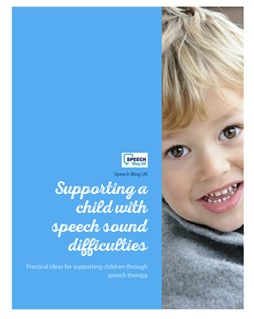 It often surprises people that I am a huge advocate of signing with children. People often think that, since speech therapists are trying to encourage children to talk, we think baby signing and similar approaches will hold back verbal language. Actually, nothing could be further from the truth! Of course, children with hearing difficulties may learn BSL (British Sign Language) or ASL (American Sign Language) and use this instead of spoken language. BSL and ASL are languages with their own grammar etc. and as such they are designed to be used with people who are going to use signing long-term as their main form of communication. However, there are many signing systems adapted from these languages (or devised entirely separately) which are really useful to use alongside speech for babies or people with language or learning difficulties. In the UK, the one used most often is Makaton, but there are also others, such as Paget-Gorman Signed Speech among others.
It often surprises people that I am a huge advocate of signing with children. People often think that, since speech therapists are trying to encourage children to talk, we think baby signing and similar approaches will hold back verbal language. Actually, nothing could be further from the truth! Of course, children with hearing difficulties may learn BSL (British Sign Language) or ASL (American Sign Language) and use this instead of spoken language. BSL and ASL are languages with their own grammar etc. and as such they are designed to be used with people who are going to use signing long-term as their main form of communication. However, there are many signing systems adapted from these languages (or devised entirely separately) which are really useful to use alongside speech for babies or people with language or learning difficulties. In the UK, the one used most often is Makaton, but there are also others, such as Paget-Gorman Signed Speech among others.
So why would we use signing with a child when we are trying to teach them to talk? Here are a few reasons:-
- Signing while you talk encourages children to look at you while you are talking. This in turn helps them to see how to say different sounds or words clearly.
- Signing helps you as an adult to keep your sentences short and simple, which will help your child to understand you better.
- Signing helps you to speak more slowly.
- Being able to sign to ask for what they want reduces children’s frustration. The more they are understood, the keener they will be to communicate.
- We all learn best when things are presented in a variety of ways. Children with language difficulties often learn better visually than by what they hear. Signing a word as well as hearing it helps a child to remember words better and therefore be able to think of them when they want to say them.
- Being able to sign when language or speech is delayed helps children to learn all the other skills involved in communication even though they don’t yet have the words. They can learn about turn-taking, asking for things, commenting and even putting words together if their signing skills become advanced enough!
It’s a difficult thing to suddenly start signing and people often feel overwhelmed by the idea. So here are a few hints on how to introduce signing if your child’s speech and language therapist has suggested it or it’s something you’d like to try while you’re waiting for an assessment.
- Introduce a few signs at a time. Start with things that your child is motivated by and wants to be able to say. Use the signs when you are talking and hopefully your child will copy. This may take a while – they will need to see you use a sign lots of times before they give it a try themselves!
- However, if they still don’t copy you after lots of repetitions, try putting your hands over theirs (if they are happy for you to) and showing them how to sign. It doesn’t have to be perfect as long as it can be understood. Don’t force this if your child doesn’t like it however.
- When you sign, always say the word as well. If your child signs without speaking to begin with, that’s fine. Praise the successful communication. When the pressure to be able to say words clearly has reduced, your child will almost certainly start to vocalise and experiment with saying the words as well.
Don’t feel that you have to sign every word, just introduce a few signs at a time and try to use them as often as you can. You’ll never manage to sign everything and it would be just as overwhelming as a constant stream of language can be!
How are you going to learn the signs to use? Makaton courses are great, but can be hard to come by. Contact Makaton or your local speech therapy department for information about trainers and courses in your area. They also sell a range of books with the signs and symbols in. Also the TV programme Something Special is great for younger children and also free! – watch with your child and learn together! Alternatively, if your child is young and late to talk, you could consider babysigning – some groups such as Tiny Talk do courses for toddlers as well as those for babies.
It’s good to pick a system and stick to it, as if different people use different signs that can be confusing. However, if all else fails or you just don’t know the signs you want, use gesture and make up your own – it’s more important to try than to get it perfect!
A word about older children before I close. Signing can still be useful for children who are using language already, particularly those with comprehension difficulties. I often use signs for particular new words (eg concept words such as same/different or big/little) or signs for question words to help children to understand which piece of information they’re being asked for. It’s another visual way to support understanding and often easier and more portable than lots of pictures!
Do you have any tips about how to introduce signing or stories of how it has helped your child? Do share them here.






Tania Allen, a Speech and Language therapist based in Kent, is also a great advocate of baby signing. We (QED) produced a pack some years ago called Accelerating Babies’ Communication. It is a really simple programme that was developed for carers to learn how to introduce baby signing and create the optimum communication environment for infants. It is available as a download from http://www.qed.uk.com/speech_language.htm
My autistic 5 year old has slowly learned a few signs, which has helped with his communication. He is almost completely non-verbal, but has begun using signs, mixed with a few words. It has been wonderful being able to finally communicate with my little boy. Thanks for confirming what we’re doing to help my son.
Elizabeth, I’m so pleased that signing has helped you to communicate with your son – taking the frustration away and developing meaningful communication is such a huge and vital step. Thanks for sharing your experience with us.
Fantastic article on why & how to sign – really well explained and clear!
I teach Sign Supported English (SSE) and tell staff (at a school & college for SLCN) all those things about why & how we sign to our children & young adults. I also teach SSE courses at local children’s centres & my intro handout is very similar!!
Although they are similar I prefer SSE to Makaton as it can be more accessible due to lots of free BSL vocabulary resources/apps, tv programmes for kids & adults, websites, etc. and a BSL 1 course can give people a huge sign language vocabulary (just ignore the BSL structure!).
I have had so many parents tell me how amazed they are at the improvement in their family life due to their child with a SLCN being able, many for the first time, to communicate what they want & how they feel by sign language. Frustrated & angry children turn into calm, content & happy ones! I love my job 🙂
Rachael
I’m glad that so many others have found signing useful. I love my job too Rachael! Interesting information about SSE, I don’t know that as well as Makaton but it certainly sounds like a useful thing to recommend.
Many of the signs are identical as SSE & Makaton are both based on BSL. I think SSE signs stick closer to BSL which is great as it gives access to the deaf world too – our school has been at events with a school for the deaf & our children mixed & signed with theirs as the signs were pretty much the same.
I also worked as a Speech and Language Therapist in a London for 6 years and loved it. I mainly worked in special schools. I am now a mother to two boys (2 and 4) and don’t want to go back to work full time. So I bought into the TinyTalk Baby Signing franchise a year ago and love it. I love teaching baby signing because I believe in it. My classes are full with waiting lists and I teach in nurseries too. My youngest used 100 signs by the time he was 1 year. Baby signing is amazing, the youngest signer I have seen was 4 months. http://Www.tinytalk.co.uk/christinap